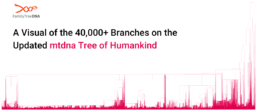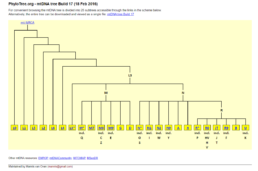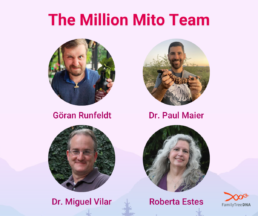By: Katy Rowe-Schurwanz
If you haven’t taken an mtDNA test yet, now is the perfect time to explore your maternal ancestry. FamilyTreeDNA’s mtDNA test provides the most detailed maternal lineage analysis available, allowing you to uncover deep ancestral roots, migration patterns, and DNA connections across generations. Learn more about mtDNA testing and start your journey today.
The mtDNA Tree of Humankind just got its biggest update yet—over 40,000 branches have been included, refining maternal ancestry research and enhancing genealogical connections.
Over the past few years, FamilyTreeDNA has been building a brand new mtDNA Tree of Humankind through the Million Mito Project. We are excited to announce that the first beta version of the Mitotree is here! Let’s examine what that means for your mtDNA results, your genealogy research, and our understanding of human history.
The Evolution of the mtDNA Tree
In 2009, scientists released an mtDNA haplotree called the PhyloTree. The PhyloTree became the academic and scientific standard, and this is the tree that FamilyTreeDNA has been using to determine your placement on the mtDNA Tree of Humankind.
The PhyloTree was updated over the years, with the last update being Version 17, released in 2016. Version 17 has about 5,400 branches and was built using publicly available data from about 24,000 full and partial mtDNA sequences.
There’s nothing wrong with the PhyloTree. However, it has only a few branches, and each was typically formed several thousand years ago. Knowing you share a matrilineal ancestor with someone in the Stone or Metal Ages is neat but not helpful for genealogy.
In 2020, Dr. Paul Maier and Göran Runfeldt from FamilyTreeDNA’s R&D department joined forces with Dr. Miguel Vilar, the lead scientist for National Geographic’s Genographic Project, and Roberta Estes, a computer scientist and genetic genealogy expert, to create the Million Mito Project.
The goal was to expand the existing mtDNA Tree of Humankind with the additional data available and create a more useful tree for finding genealogical connections.
The World’s Largest mtDNA Haplotree
The Million Mito Team has worked tirelessly to expand the mtDNA Haplotree. Using over half a million mtDNA results from testers across FamilyTreeDNA and the Genographic Project and from academic sources, our team has created the world’s largest mtDNA Tree of Humankind.
The updated mtDNA Haplotree has over 40,000 branches—practically 35,000 more than the PhyloTree!

We’ve also added many ancient branches representing ancestors who lived so long ago that their names have been lost to time. The first was haplogroup L7, added to the mtDNA Haplotree in June 2022, inserting a new 100,000-year-old story into our collective matrilineal past.
How This Update Affects Your Results
You won’t see any significant changes to your mtDNA reports that previously existed quite yet, and likely won’t until the beta period has ended*.
However, we have:
- Updated the look of your mtDNA Matches page
- Assigned you a second haplogroup from the Updated mtDNA Haplotree
- Added many new reports in mtDNA Discover, all available right now
Understanding Your mtDNA Matches
Once the beta period ends and the Mitotree becomes official, you may see changes to your mtFull Sequence matches.
To be an mtDNA match, there are specific requirements two testers must meet.
At the two lowest matching levels, Hypervariable Region (HVR) 1 and HVR 1 and 2, the testers must be an exact match– meaning there are no differences between their mtDNA results in those HVR sections. You may have matches at these levels with the same root haplogroup (the first letter, like H, V, or K), but they may belong to different subclades than you (your haplogroup might be H1a, and a match’s might be H1b).
For the highest matching level, the Coding Region, tested only by the mtFull Sequence test, two testers can have up to three differences in their mtDNA results, but they must have the exact same haplogroup. So if your haplogroup is H1a, all of your Coding Region level matches are also H1a.
Since the Mitotree is adding younger branches to the mtDNA Haplotree, there may be mtDNA testers who are related to you within a genealogical timeframe but have been placed on a different branch of the tree, like what you’d see in your Y-DNA results.
Our scientists will be working to determine a new mtDNA matching algorithm that will be released when the beta period ends. More details will be provided when we are closer to the release timeframe.
*During the research phase, the Million Mito Team discovered some testers whose PhyloTree haplogroups need to be adjusted. Testers will be notified about any changes that are made. Since who your mtDNA matches are is tied to your PhyloTree haplogroup, these testers will also see changes in their match lists.
A New Look for the mtDNA Matches Page
Your mtDNA Matches page has a brand-new look! If you work with Family Finder or Y-DNA results, you’ll probably be pretty familiar with the new style. You’ll now be able to see more information about your mtDNA matches, including:
- Their Maternal County of Origin, based on the country entered for their maternal Earliest Known Ancestor
- Their updated mtDNA haplogroup and haplotype, based on the new Mitotree
Your Updated mtDNA Haplogroup
When you sign in, you’ll see both your updated mtDNA haplogroup, based on the new tree, and your legacy mtDNA haplogroup, based on the old tree. Both haplogroups and badges will continue to be assigned throughout the beta period.
During the beta period, you may notice changes in your haplogroup and upstream of your placement as our scientists continue working on the structure of the Mitotree and names of the various haplogroups.
After the beta period has ended, you may receive a new updated mtDNA haplogroup from time to time as more testers receive results and new branches are added to the Mitotree.
New Reports in mtDNA Discover
One of the most exciting improvements! We’ve added new mtDNA reports to help you determine where your ancestors were from and find connections with your matches, including:
- Haplogroup Story: Explore the history of your direct maternal lineage, from its ancient origins to modern-day connections.
- Country Frequency: See where your haplogroup is most commonly found today based on tester data and academic studies.
- Ancient Connections: Discover ancient individuals from your maternal line, identified through DNA from archaeological remains.
- Notable Connections: Find fun historical connections to well-known figures who share your haplogroup.
- Migration Map: Trace your maternal lineage’s migration from Africa to present-day locations, with insights from ancient DNA.
- Time Tree: View a time-scaled genetic tree that estimates when your maternal ancestors lived and how they connect to others.
- Match Time Tree (mtFull Exclusive): See how you and your mtDNA matches fit into a shared genetic tree, removing the guesswork in understanding relationships.
- Ancestral Path: Follow the genetic path of your maternal lineage, showing each step back to our common ancestor from 140,000 years ago.
- Classic Tree: Explore the full FamilyTreeDNA Mitotree, combining modern tester data with ancient and academic samples.
- Suggested Projects: Find community projects relevant to your haplogroup, where administrators can help interpret your results.
- Coming Soon! Globetrekker and Group Time Tree (mtFull Exclusive): Get ready for even more insights into your maternal ancestry!
Check out all of your new reports by clicking on the Discover Haplogroup Reports button under the mtDNA section of your results. You can read more about each new report in our Help Center.
More mtDNA Updates & Features
- Group Project mtDNA Results: Added a column for Mitotree haplogroup
- Group Administrator Reports: Added a column for Mitotree haplogroup to the mtDNA Results, mtDNA Results Classic, and Member Subgrouping reports.
- Advanced Matches: Added a column for Mitotree haplogroup
- Profile Cards: Added Mitotree haplogroup, Kit Manager name, Earliest Known Ancestor County of Origin, and added back the My Personal Story section.
- Coming Soon: Adding Mitotree haplogroups to Family Finder Matches and additional Group Project and Administrator reports.
How This Update Helps Genealogy Research
With the extra refinement they provide, the new updated mtDNA haplogroups may help you determine which mtDNA matches you share a common ancestor with more recently.
For example, the Match Time Tree report, exclusive to mtFull Sequence testers, which uses the Mitotree Time to Most Recent Common Ancestor Age Estimates to place you and your Coding Region level matches on a genetic family tree, can help you quickly visualize when your shared ancestor with each match is estimated to have lived.
Other new reports, such as the Country Frequency Map and the soon-to-be-released Globetrekker, can help you identify where your ancestors came from and how they got there.
We’ll add more blog articles soon that provide an in-depth guide on using your new haplogroup and the new reports to benefit your genealogy research. Make sure you’ve subscribed to the blog so you don’t miss out!
What the mtDNA Tree Reveals About Human History
The over 35,000 new branches on the Mitotree represent over 35,000 new ancestors that we can learn about.
Our Million Mito Team added one example to the mtDNA Haplotree in June 2022. When the team began analyzing mtDNA sequences, they found 19 that did not fit into the current haplotree structure—there was no place for them on the tree. These testers formed a brand new branch on the mtDNA Tree of Humankind that was 100,000 years old!
The new L7 lineage first emerged in ancient Africa 100,000 years ago– it is the third oldest mtDNA haplogroup.
Based on ancient DNA samples and locations of modern-day testers that have been reclassified as belonging to L7, we’ve concluded that this lineage formed in Eastern Africa around the Great Rift Valley.
Eastern Africa’s Great Rift Valley has long been a source of many amazing human evolutionary discoveries, including the famous “Lucy,” an Australopithecus afarensis hominid from 3 million years ago, two additional 10 million-year-old hominids, and the Laetoli Footprints—a trail of 70 preserved early hominid footprints from 3.6 million years ago in Tanzania.
The rapidly eroding highlands and volcanic activity of the region provided favorable conditions for the preservation of so many ancient human fossils, helping shape human history and connect it to the present.
How to Find Your Updated mtDNA Haplogroup
Your mtDNA haplogroup defines your direct maternal lineage, tracing your ancestry back thousands of years. With the latest update to the mtDNA Tree of Humankind, your haplogroup assignment has been refined, providing more precise placement and deeper ancestral insights.
Whether you’re an existing mtFull Sequence tester, awaiting results, or considering an upgrade, here’s how you can access your updated haplogroup and explore new discoveries in mtDNA Discover.
For mtFull Sequence Testers: What to Expect
If you currently have mtFull Sequence results, your new haplogroup will be assigned within the next few weeks, and you’ll receive an email notification once it’s ready. Once you’ve received that notification, you can sign in to your account and view your new haplogroup on the Mitotree badge on your dashboard.
Under your mtDNA Results & Tools section, click Matches to view the updated match page and Discover Haplogroup Reports to explore your new mtDNA reports. mtDNA Discover can also be accessed by clicking on your haplogroup badges.
Waiting on Results? Here’s What You Need to Know
If you are currently awaiting mtFull Sequence results, your data will be analyzed once your results are available, and you will be placed on the Mitotree soon after.
New mtFull Sequence results may not initially receive a placement on the Mitotree during the beta phase. We’re working to establish a weekly update cycle to place new results, but there may be initial delays. We will email you when your Updated mtDNA Haplogroup is available.
You will receive a placement on the PhyloTree when your results are completed, and you can access the new mtDNA Discover reports for your legacy mtDNA haplogroup. Under your mtDNA Results & Tools section, click Discover Haplogroup Reports to explore your new mtDNA reports. mtDNA Discover can also be accessed by clicking on your haplogroup badge.
How This Affects Lower-Level mtDNA Tests
For customers with a lower-level mtDNA test such as the mtPlus or mtDNA (HVR 1), or Genographic Project 2 or Next Generation transfers, updated mtDNA haplogroups and placements on the Mitotree are only available with mtFull Sequence results.
Sign in to your account and click “Add ons and upgrades” near the top right to purchase an upgrade to the mtFull Sequence.
mtDNA Discover reports are available for legacy haplogroups from the PhyloTree. However, you will receive the most precise information and relevant matches for your genealogy from the reports with the mtFull Sequence. Under your mtDNA Results & Tools section, click Discover Haplogroup Reports to explore your new mtDNA reports. mtDNA Discover can also be accessed by clicking on your haplogroup badge.
Don’t Have an mtDNA Test? Here’s How to Get One
If you have a Y-DNA test, Family Finder, or Autosomal Transfer for yourself with FamilyTreeDNA, sign in to your account. Click “Add ons and upgrades” near the top right to purchase an upgrade to the mtFull Sequence.
If you want to purchase an mtFull Sequence for someone who has not tested with or transferred their DNA to FamilyTreeDNA, please follow the steps for new customers below.
If you or the person you would like to test has not yet tested with FamilyTreeDNA, make sure you are not signed in to an existing account before purchasing an mtFull Sequence test.
*Each FamilyTreeDNA account is designed to hold only one person’s DNA results. Any tests purchased while signed in to an existing account will be processed on that tester’s submitted DNA sample. To purchase a test for a different person, please make sure you are not signed in to an existing account for anyone else.
Learn More: Resources & Community
We’ve added many useful articles to our Help Center, including pages for each of the mtDNA Discover reports, information about how to read the new Mitotree, and updated information for the mtDNA Matches page.
You can read more about the new mtDNA Discover reports from the FamilyTreeDNA blog.
Questions, concerns, and feedback can be directed to Customer Support.
You can also discuss the updates in the Mitochondrial DNA for Genealogy Facebook group, sponsored by DNA-Explain.

About the Author
Katy Rowe-Schurwanz
Product Manager at FamilyTreeDNA
Katy Rowe-Schurwanz has always been interested in genealogy, inspired by her maternal grandparents, who told her stories about their family and family history when she was little. After studying anthropology and history in college, she joined FamilyTreeDNA in 2015 and became the Trainer for Customer Support. Katy created and improved training processes and was fundamental in the creation of the Big Y Specialist team. In September 2021, she became Product Manager and has focused closely on improving FamilyTreeDNA’s genetic genealogy products.






